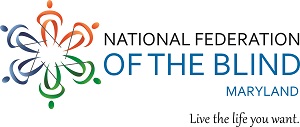Download this 2025 Annapolis Day fact sheet
Subject: Improving Transportation: Use of Autonomous Vehicles for Persons with Disabilities
From: Members of the National Federation of the Blind of Maryland
To: Members of the Maryland General Assembly
Contact: Ronza Othman, President
National Federation of the Blind of Maryland
15 Charles Plaza, #3002
Baltimore, MD 21201
Phone: 443-426-4110
Email: President@nfbmd.org
Date: January 16, 2025
THE PROBLEM
Blind people who wish to move about their communities experience lack of sufficient, effective, affordable, or discrimination-free transportation options. Bus services are overtaxed, under-funded, and often inefficient. Paratransit services are even worse. Rideshare drivers regularly discriminate against blind and low vision passengers, with nearly 100% of guide dog users reporting rideshare denials and more than 50% of blind cane users reporting rideshare denials due to blindness. Many of those report multiple rideshare service denials in a given week.
Autonomous vehicle technology exists that does not require a human driver, with 25 states having passed legislation allowing for the field testing or commercial operation of autonomous vehicles. Maryland is not yet one of them.
PROPOSED ACTION
The Maryland General Assembly should pass legislation to permit field testing and/or commercial operation of autonomous vehicles in Maryland. This legislation should ensure that blind and low vision individuals as well as those with disabilities generally, are able to independently access these vehicles given that the technology exists that does not require a human operator to control the vehicle by prohibiting the need for a valid driver’s license to operate these vehicles.
BACKGROUND
Twenty-five states have passed legislation allowing for the field testing or commercial operation of autonomous vehicles.
A fully autonomous vehicle is a self-guided vehicle that operates without any human interaction, using specially designed software, artificial intelligence and sensors including cameras, radar, and infrared lasers (lidar) to understand and perceive surroundings. This is similar to how a human driver uses eyesight and hearing to perceive the environment and cognition to make decisions and operate a motor vehicle.
The Society of Automotive Engineers (SAE) separates autonomous vehicle technology into levels of autonomous operations ranging from human assisted driving to full automation. SAE level 4 and SAE level 5 are fully autonomous technology, meaning that a human driver is not necessary in any capacity for these vehicles to operate on roadways. Companies in the US currently operate commercial rideshare services in San Francisco, Los Angeles, and Phoenix using SAE level 4, fully autonomous vehicles, with Austin and other cities beginning shortly. This means that an individual can summon a fully autonomous vehicle in one of these cities as easily as ordering an Uber or Lyft. They need to simply download the requisite app, enter payment information, and summon a fully autonomous vehicle. This is not science fiction. It is reality in these 3 cities and several more are on the horizon.
Currently there is not a nationwide federal law regulating fully autonomous vehicles. California and Arizona, along with twenty-three states, have passed state legislation permitting the testing and operation of SAE level 4 autonomous vehicles within their borders. The blind community is poised to benefit from autonomous vehicle technology more than any other community; therefore the National Federation of the Blind of Maryland wants to see Maryland become the 26th state to implement a similar statewide framework.
Fully autonomous vehicles are not controlled by human drivers, which eliminates discrimination from the conversation when requesting an autonomous rideshare. Passengers do not have to fear suffering refusal of a ride for being a blind person using a service animal, or white cane. The broader community does not need to live in fear of experiencing discrimination based upon religion, skin color or LGBTQ+ identity. Vulnerable men and women can feel safe knowing they are not entering a car with a stranger. Anyone can ride comfortably with the knowledge that the autonomous driver will not be intoxicated or distracted by a text message. Any passenger in an autonomous vehicle will have the same freedom to make a phone call or have a private conversation as they would experience while driving their own personal vehicle.
The National Federation of the blind headquarters in Baltimore Maryland is dedicated to sharing expertise to make sure that fully autonomous vehicles operating in Maryland would be implementing best practices for nonvisual accessibility through the Center of Excellence in Non-Visual access, putting Maryland once again front and center in the conversation of cutting-edge developments while ensuring accessibility.
CONCLUSION
We encourage the adoption of Maryland Autonomous Vehicle regulations that conform with the best practices in other states. Eliminating the requirement of a licensed human driver in the vehicle and maintaining comparable language to the District of Columbia will ensure people working in the DC Metro Area would be able to reliably commute between home and work creating more choice in transportation for everyone. Use of autonomous vehicles in Maryland will also reduce instances of discriminatory rideshare denials for the blind.
